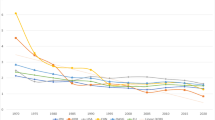Abstract
Trade in Australian education services has expanded rapidly over recent years. The sector is the third largest exporter of Australian services. In 2001–2002, exports of education were about $A 4.2 billion. Government assistance to the sector includes export market development, regulation of education standards, and funding education activities; university research and development, for example. This paper examines the case for further government intervention in the export of education, and the appropriate forms of assistance if further government intervention is justified. The paper predominately focuses on assisting higher education exports because this activity dominates education exports.
Similar content being viewed by others
References
Austrade (2000). Review of Export Development Grants Scheme. Sydney: Austrade. http://www.austrade.gov.au.
Australian Bureau of Statistics (2002). Australian Social Trends 2002, Education – Participation in Education: Overseas Students. http://www.abs.gov.au/ausstats.
Australian Bureau of Statistics (2003a). ‘International Accounts and Trade Feature Article – International Trade in Education Services’, Balance of Payments and International Investment Position Australia 2002 (Cat no. 5302.0). http://www.abs.gov.au/ausstats.
Australian Bureau of Statistics (2003b). Measuring Learning in Australia: A Framework for Education and Training Statistics (Cat no. 4213.0). http://www.abs.gov.au/ausstats.
AEI – International Education Network, Department of Education, Science and Training (2003a). ‘Budget 2003: International Education Initiatives’. http://aei.dest.gov.au/budget/default.htm.
AEI – International Education Network, Department of Education, Science and Training (2003b). Getting Started Internationally: Tips for Schools Entering the International Market http://aei.detya.gov.au/ASC/Free_pubs/tips/tips2.pdf.
AEI – International Education Network, Department of Education, Science and Training (2004). Competitor Analysis: Australia’s Competitors in International Education for the US, UK, Canada and New Zealand AEI Canberra
Australian Vice-Chancellors Committee (2003). ‘New Taxes a Set Back for Education Exports’, Media Release, 13 May http://www.avcc.edu.au/news/public_statements/media_releases/2003.
Bureau of Industry Economics (1992). Recent Developments in the Theory of Economic Growth: Policy Implications, Occasional Paper 11 Canberra Australian Government Printing Service
R. Carrington T. Coelli D.S.P. Rao (2005) ArticleTitleThe performance of Australian universities: conceptual issues and preliminary results Economic Papers 24 145–163 Occurrence Handle10.1111/j.1759-3441.2005.tb01001.x
Department of Eduction Training and Science (2002). Review of Australian Education International Canberra Department of Eduction Training and Science
Department of Eduction Training and Science (2003). ‘National Literacy and Numeracy Benchmarks’. http://www.dest.gov.au/schools/Literacy&Numeracy/benchmarks.htm.
Gallagher, M. (2002), ‘On a Cusp – A New Phase in the Internationalisation of Australian Education’, Notes for Discussion at the 16th Australian International Education Conference. Hobart. http://www.idp.com/16aiecpapers/.
J. Giesecke (2004) The Economic Effects of International Students in Australia AEI Canberra
Institution of Engineers, Australia (2003). ‘Singapore – Australia Free Trade Agreement’, Submission to the Joint Standing Committee on Treaties, May. http://www.ieaust.org.au.
Industry Commission. (1991). Exports of Education Services, Report No. 12 Canberra Australian Government Printing Service
P. Karmel (2003) ArticleTitleHigher education at the crossroads: response to an Australian Ministerial Discussion Paper Higher Education 45 1–18 Occurrence Handle10.1023/A:1021238607360
P. Kenyon P. Koshy (2003) The Economic Benefits to Australia from International Education AEI Canberra
Knight, J. (2003) GATS, Trade and Higher Education: Perspective 2003 – Where are We? The Observatory on Borderless Higher Education, London. http://www.obhe.ac.uk.
K. Larsen J.P. Martin R. Morris (2002) ArticleTitleTrade in education services: trends and emerging issues World Economy 26 IssueID6 849–68 Occurrence Handle10.1111/1467-9701.00466
J. Mallea (1998) International Trade in Professional and Educational Services: Implications for the Professions and Higher Education CERI/OECD Paris
Nelson, B. (2002). Higher Education at the Crossroads: An Overview Paper, Ministerial Paper. Canberra: Department of Education, Science and Training. http://www.dest.gov.au.
Nelson, B. (2004). ‘Learning Together: Achievement Through Choice and Opportunity’ Media Release, 11 May 2004. http://www.dest.gov.au/ministers/nelson/budget04/bud27_04.htm.
Nguyen-Hong, D. and Wells, R. (2003). Restrictions on Trade in Education Services: Some Basic Indexes Productivity Commission Staff Working Paper Canberra
Parham, D. (2002). ‘Australia’s 1990s Productivity Surge and its Determinants’ 13th Annual East Asian Seminar on Economics, National Bureau of Economic Research Melbourne 20–22 June
Phillips, M. and Stahl, C.W. (2000). ‘Internationalisation of Education, Training and Professional Services: Trends and Issues’. Capstrans Working Paper, July
Productivity Commission (2000). Productivity Commission Submission to the Review of the Export Market Development Grants Scheme, Canberra. http://www.pc.gov.au.
Productivity Commission (2002). University Resourcing: Australia in an International Context, Research Report, December. http://www.pc.gov.au.
Revesz, J. and Lattimore, R. (2001). Statistical Analysis of the Use of Government Business Programs. Productivity Staff Research Paper. Canberra: AusInfo. http://www.pc.gov.au.
Steering Committee for the Review of Government Service Provision (2005). Report on Government Services. http://www.pc.gov.au.
The Sydney Morning Herald (2003) ‘Uni plan to make ends meet: 30% hike’, 24 June. http://www.smh.com.au/articles/2003/06/23/1056220544470.html.
Temple J. (2000). ‘Growth Effects of Education and Social Capital in the OECD Countries’, Economics Department Working Papers No. 263. Paris: OECD. http://www.oecd.org/eco/eco.
Vaile, M. and Yeo, G. (2003). ‘Signing of the Singapore–Australia Free Trade Agreement’, Joint Media Release, 17 February. http://www.trademinster.gov.au.
C. Ziguras G. McBurnie L. Reinke (2002) Strategies for Negotiating Trade in Education of Services AEI Canberra
Author information
Authors and Affiliations
Corresponding author
Rights and permissions
About this article
Cite this article
Carrington, R., Meek, V.L. & Wood, F.Q. The role of further government intervention in Australian international education. High Educ 53, 561–577 (2007). https://doi.org/10.1007/s10734-005-8755-0
Issue Date:
DOI: https://doi.org/10.1007/s10734-005-8755-0




